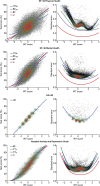Psychometric properties of Short Form-36 Health Survey, EuroQol 5-dimensions, and Hospital Anxiety and Depression Scale in patients with chronic pain
- PMID: 31568237
- PMCID: PMC6940032
- DOI: 10.1097/j.pain.0000000000001700
Psychometric properties of Short Form-36 Health Survey, EuroQol 5-dimensions, and Hospital Anxiety and Depression Scale in patients with chronic pain
Abstract
Recent research has highlighted a need for the psychometric evaluation of instruments targeting core domains of the pain experience in chronic pain populations. In this study, the measurement properties of Short Form-36 Health Survey (SF-36),EuroQol 5-dimensions (EQ-5D) and Hospital Anxiety and Depression Scale (HADS) were analyzed within the item response-theory framework based on data from 35,908 patients. To assess the structural validity of these instruments, the empirical representations of several conceptually substantiated latent structures were compared in a cross-validation procedure. The most structurally sound representations were selected from each questionnaire and their internal consistency reliability computed as a summary of their precision. Finally, questionnaire scores were correlated with each other to evaluate their convergent and discriminant validity. Our results supported that SF-36 is an acceptable measure of 2 independent constructs of physical and mental health. By contrast, although the approach to summarize the health-related quality of life construct of EQ-5D as a unidimensional score was valid, its low reliability rendered practical model implementation of doubtful utility. Finally, rather than being separated into 2 subscales of anxiety and depression, HADS was a valid and reliable measure of overall emotional distress. In support of convergent and discriminant validity, correlations between questionnaires showed that theoretically similar traits were highly associated, whereas unrelated traits were not. Our models can be applied to score SF-36 and HADS in chronic pain patients, but we recommend against using the EQ-5D model due to its low reliability. These results are useful for researchers and clinicians involved in chronic pain populations because questionnaires' properties determine their discriminating ability in patient status assessment.
Conflict of interest statement
The authors have no conflicts of interest to declare.
Sponsorships or competing interests that may be relevant to content are disclosed at the end of this article.
Figures



Comment in
-
Is health-related quality of life a useful outcome in pain intervention research?Pain. 2020 Jan;161(1):1-2. doi: 10.1097/j.pain.0000000000001701. Pain. 2020. PMID: 31568236 No abstract available.
Similar articles
-
Psychometric properties of the EuroQol Five Dimensional Questionnaire (EQ-5D-3L) in caregivers of autistic children.Qual Life Res. 2013 Dec;22(10):2909-20. doi: 10.1007/s11136-013-0423-8. Epub 2013 Apr 25. Qual Life Res. 2013. PMID: 23615959
-
Psychometric evaluation of the Hospital Anxiety and Depression Scale 3 months after acute lung injury.J Crit Care. 2015 Aug;30(4):793-8. doi: 10.1016/j.jcrc.2015.04.006. Epub 2015 Apr 17. J Crit Care. 2015. PMID: 25981443 Free PMC article.
-
Health-related quality of life in patients with polycystic ovary syndrome: validation of the German PCOSQ-G.Arch Gynecol Obstet. 2018 Apr;297(4):1027-1035. doi: 10.1007/s00404-017-4623-2. Epub 2017 Dec 16. Arch Gynecol Obstet. 2018. PMID: 29249009 Free PMC article.
-
Psychometric properties of the Hospital Anxiety and Depression Scale (HADS) in individuals with stable chronic obstructive pulmonary disease (COPD): a systematic review.Disabil Rehabil. 2024 Apr;46(7):1230-1238. doi: 10.1080/09638288.2023.2182918. Epub 2023 Mar 2. Disabil Rehabil. 2024. PMID: 36861817
-
Patient-reported outcome measures for systemic lupus erythematosus clinical trials: a review of content validity, face validity and psychometric performance.Health Qual Life Outcomes. 2014 Jul 22;12:116. doi: 10.1186/s12955-014-0116-1. Health Qual Life Outcomes. 2014. PMID: 25048687 Free PMC article. Review.
Cited by
-
Acceptance and Fear-Avoidance Mediate Outcomes of Interdisciplinary Pain Rehabilitation Programs at 12-Month Follow-Up: A Clinical Registry-Based Longitudinal Cohort Study from the Swedish Quality Registry for Pain Rehabilitation (SQRP).J Pain Res. 2024 Jan 5;17:83-105. doi: 10.2147/JPR.S438260. eCollection 2024. J Pain Res. 2024. PMID: 38196970 Free PMC article.
-
Automated Nociceptive Withdrawal Reflex Measurements Reveal Normal Reflex Thresholds and Augmented Pain Ratings in Patients with Fibromyalgia.J Clin Med. 2020 Jun 25;9(6):1992. doi: 10.3390/jcm9061992. J Clin Med. 2020. PMID: 32630430 Free PMC article.
-
Predictors of the Health-Related Quality of Life (HRQOL) in SF-36 in Knee Osteoarthritis Patients: A Multimodal Model With Moderators and Mediators.Cureus. 2022 Jul 27;14(7):e27339. doi: 10.7759/cureus.27339. eCollection 2022 Jul. Cureus. 2022. PMID: 36042993 Free PMC article.
-
Prognostic Factors for Quality of Life After Interdisciplinary Pain Rehabilitation in Patients with Chronic Pain-A Systematic Review.Pain Med. 2023 Jan 4;24(1):52-70. doi: 10.1093/pm/pnac098. Pain Med. 2023. PMID: 35736398 Free PMC article.
-
Interdisciplinary pain rehabilitation for immigrants with chronic pain who need language interpretation.J Rehabil Med. 2024 Feb 26;56:jrm13466. doi: 10.2340/jrm.v56.13466. J Rehabil Med. 2024. PMID: 38407432 Free PMC article.
References
-
- Beals J, Welty TK, Mitchell CM, Rhoades DA, Yeh JL, Henderson JA, Manson SM, Buchwald DS. Different factor loadings for SF36: the Strong Heart Study and the National Survey of Functional Health Status. J Clin Epidemiol 2006;59:208–15. - PubMed
-
- Bjelland I, Dahl AA, Haug TT, Neckelmann D. The validity of the Hospital Anxiety and Depression Scale. An updated literature review. J Psychosom Res 2002;52:69–77. - PubMed
-
- Bock RD, Aitkin M. Marginal maximum likelihood estimation of item parameters: application of an EM algorithm. Psychometrika 1981;46:443–59.
-
- Borsboom D, Mellenbergh GJ, van Heerden J. The theoretical status of latent variables. Psychol Rev 2003;110:203–19. - PubMed
-
- Brandberg Y, Bolund C, Sigurdardottir V, Sjödén PO, Sullivan M. Anxiety and depressive symptoms at different stages of malignant melanoma. Psycho Oncol 1992;1:71–8.

